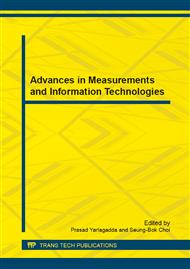[1]
McNamara, J.A., Connolly, B.P., 1999. Retinopathy of prematurity. In: Regillo, C.D., Brown, C.G., Flynn, H.W. (Eds. ), Vitreoretinal Disease: The Essentials. Thieme Medical Publishers, New York, p.177–192.
Google Scholar
[2]
Palmer, E.A., Flynn, J.T., Hardy, R.J., Phelps, D.L., Phillips, C.L., Schaffer, D.B., 1991. Incidence and early course of retinopathy of prematurity. Ophthalmology 98, 1628–1640.
DOI: 10.1016/j.ophtha.2020.01.034
Google Scholar
[3]
Early Treatment For Retinopathy Of Prematurity Cooperative, G. (2003).
Google Scholar
[4]
Henegan C, Flynn J, O'Keefe M, et al. Characterization of changesin blood vessel width and tortuosity in retinopathy of prematurity using image analysis. Med Image Anal. 2002; 6(4): 407– 429.
DOI: 10.1016/s1361-8415(02)00058-0
Google Scholar
[5]
Swanson C, Cocker KD, Parker KH, et al. Semiautomated computer analysis of vessel growth in preterm infants without and with ROP. Br J Ophthalmol. 2003; 87(12): 1474–1477.
DOI: 10.1136/bjo.87.12.1474
Google Scholar
[6]
Gelman R, Martinez-Perez ME, Vanderveen DK, et al. Diagnosis of plus disease in retinopathy of prematurity using Retinal Image multiScale Analysis. Invest Ophthalmol Vis Sci. 2005; 46(12): 4734-4738.
DOI: 10.1167/iovs.05-0646
Google Scholar
[7]
Wallace DK, Zhao Z, Freedman SF, A pilot study using ROPtool, to quantify plus disease in retinopathy of prematurity. J AAPOS2007; 11(4): 381-387.
DOI: 10.1016/j.jaapos.2007.04.008
Google Scholar
[8]
Lassada Sukkaew, Bunyarit Uyyanonvara, Sarah Barman, Alistair Fielder, Ken Cocker, Automatic extraction of the structure of the retinal blood vessel network of premature infants, Journal of Medical Association of Thailand , Vol. 90, No. 9, 2007, pp.1780-1792.
Google Scholar
[9]
Lassada Sukkaew, Bunyarit Uyyanonvara, Stanislav S. Makhanov, Sarah Barman, and Pannet Pangputhipong, Automatic Tortuosity- Based Retinopathy of Prematurity screening system, IEICE Trans. INF. & SYST., VOL. E91-D, NO. 12 DECEMBER (2008).
DOI: 10.1093/ietisy/e91-d.12.2868
Google Scholar
[10]
Chapman, N., Witt, N., Gao, X., Bharath, A.A., Stanton, A.V., Thom, S.A., Hughes, A.D., 2001. Computer algorithms for the automated measurement of retinal arteriolar diameters. Brit. J. Ophthalmol. 85, 74–79.
DOI: 10.1136/bjo.85.1.74
Google Scholar
[11]
[My paper] Chiang, M. F., R. Gelman, et al. (2007). Plus disease in retinopathy of prematurity: an analysis of diagnostic performance., Trans Am Ophthalmol Soc 105: 73-84; discussion 84-75.
Google Scholar
[12]
Wallace DK, Computer-assisted quantification of vascular tortuosity in retinopathy of prematurity (2007) An American Ophthalmological Society PhD thesis, Trans Am Ophthalmol Soc. 105: 594-615.
Google Scholar
[13]
Wallace, D. K., G. E. Quinn, et al. (2008). Agreement among pediatric ophthalmologists in diagnosing plus and pre-plus disease in retinopathy of prematurity., J AAPOS 12(4): 352-356.
DOI: 10.1016/j.jaapos.2007.11.022
Google Scholar
[14]
Wilson, C. M., K. D. Cocker, et al. (2008). Computerized analysis of retinal vessel width and tortuosity in premature infants., Invest Ophthalmol Vis Sci 49(8): 3577-3585.
DOI: 10.1167/iovs.07-1353
Google Scholar
[15]
Aslam T, Fleck B, Patton N, Trucco M, Azegrouz H (2009) Digital image analysis of plus disease in retinopathy of prematurity. Acta Ophthalmol 87: 368-377.
DOI: 10.1111/j.1755-3768.2008.01448.x
Google Scholar
[16]
Amanda E Kiely, David K Wallace, Sharon F Freedman, Zheen Zhao., 2010. Computer-assisted measurement of retinal vascular width and tortuosity in retinopathy of prematurity. Arch Ophthalmol. 2010 Jul ; 128 (7): 847-52.
DOI: 10.1001/archophthalmol.2010.133
Google Scholar
[17]
Wallace, D.K., Kylstra, J.A., Chesnutt, D.A., 2000. Prognostic significance of vascular dilation and tortuosity insufficient for plus disease in retinopathy of prematurity. Journal of AAPOS 4, 224–229.
DOI: 10.1067/mpa.2000.105273
Google Scholar
[18]
Saunders, R.A., Donahue, M.L., Berland, J.E., Roberts, E.L., Von Powers,B., Rust, P.F., 2000. Non-ophthalmologist screening for retinopathy of prematurity. Brit. J. Ophthalmol. 84, 130–134.
DOI: 10.1136/bjo.84.2.130
Google Scholar
[19]
S D Schwartz, S A Harrison, P J Ferrone, M T Trese, Telemedical evaluation and management of retinopathy of prematurity using a fiberoptic digital fundus camera, Ophthalmology 2000; 107, 25-28.
DOI: 10.1016/s0161-6420(99)00003-2
Google Scholar
[20]
D B Roth, D Morales, W J Feuer, D Hess, R A Johnson, J T Flynn. Screening for Retinopathy of Prematurity Employing the RetCam 120,. Arch Ophthalmology 2001; 119, 268-272.
Google Scholar
[21]
R S Newsom, C Sinthanayothin, J Boyce, A G Casswell, T H Williamson, Clinical evaluation of `local contrast enhancement' for oral fluorescein angiograms, Eye 2000 14, 318-323.
DOI: 10.1038/eye.2000.80
Google Scholar
[22]
S A Barman, E J Hollick, J F Boyce, D J Spalton, B Uyannovara, W R Meacock, G Sanguinetti, Quantification of posterior capsule opacification in digital retroillumination images using a computational method based on texture analysis, IOVS, 2000; 41: 3882-3892.
DOI: 10.1117/12.387597
Google Scholar
[23]
R. Turior, D. Onkaew , B. Uyyanonvara , PCA-based Retinal Vessel Tortuosity Quantification, IEICE Trans. INF. & SYST , E96-D(2), pp.329-339, Feb2013.
DOI: 10.1587/transinf.e96.d.329
Google Scholar
[24]
R. Turior, D. Onkaew, B. Uyyanonvara, P. Chutinantvarodom, Quantification and Classification of Retinal Vessel Tortuosity, Science Asia Journal, in press.
DOI: 10.2306/scienceasia1513-1874.2013.39.265
Google Scholar
[25]
Danu Onkaew, Rashmi Turior, Bunyarit Uyyanonvara, Nishihara Akinori, Chanjira Sinthanayothin, Automatic Retinal Vessel Tortuosity Measurement using Curvature of Improved Chain Code, International Conference on Electrical, Control and Computer Engineering (InECCE 2011), pp.183-186.
DOI: 10.1109/inecce.2011.5953872
Google Scholar
[26]
Rashmi Turior, Bunyarit Uyyanonvara, Pornthep Chutinantvarodom, Khakima Karimzade, Quantitative measurement of changes in retinal vessel diameters in Preterm infants, International Conference on Medical Physics and Biomedical Engineering (ICMPBE 2012), Vol. 13, pp.335-340, Qingdao, China, 8-9 September, (2012).
Google Scholar
[27]
M Ramaswamy et al, A Study and Comparison of Automated Techniques for Exudate Detection Using Digital Fundus Images of Human Eye: A Review for Early Identification of Diabetic Retinopathy Int. J. Comp. Tech. Appl., Vol 2 (5), 1503-1516.
Google Scholar
[28]
Sanchez, C.I.; Hornero, R.; Lopez, M.I.; Poza, J. Retinal Image Analysis to Detect and Quantify Lesions Associated with Diabetic Retinopathy. In Internat. Conf. on Engineering in Medicine and Biology Society (EMBC), 2004, p.1624 – 1627.
DOI: 10.1109/iembs.2004.1403492
Google Scholar
[29]
An International Committee for the Classification of Retinopathy of Prematurity. The International Classification of Retinopathy of Prematurity Revisited. Arch Ophthalmol 2005; 123: 991-999.
DOI: 10.1001/archopht.123.7.991
Google Scholar


